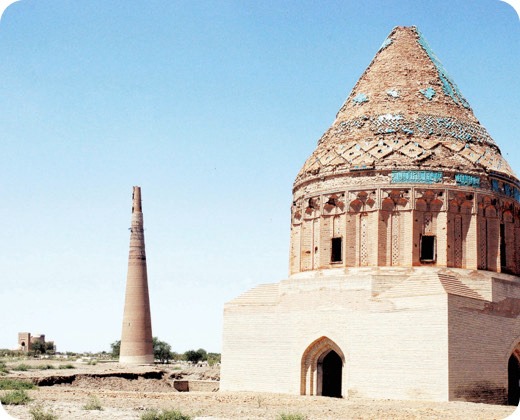Historical sources do not tell us anything about the date of the birth of Khorezmshah Tekesh (r. 1172-1200). We can only assume that his father, Il Arsla, was born between 1117 and 1118 and married between 17 and 18 years old, and that Tekesh was born between 1135 and 1136. If this is the case, Tekesh ascended the throne of the Khorezmshah dynasty at the age of 37-38. The name of the tekesh was inscribed in Bukhara. Tekesh was an accomplished diplomat. The work of Soltan’s private secretary, Muhammad Baghdadi, “At-tawassul ila-t-tarrasul” (“Studies on the Exchange of Active Correspondence”), is a valuable source in the history of Turkmen diplomacy. Sultan Tekesh had opposed the Abbasi Caliph’s demand for full ownership of the Iraqi Seljuk heritage. Alp had succeeded in attracting the Gypsies under the leadership of Kara. In order to strengthen his friendship with the Gypsies, Khan Jankishi’s daughter was married to Turkan (he was of the Bayat tribe – J.G.). Turkic tribes such as the Turkic tribes, such as the Urgan, the Garlyk, the Ugrak, and the Halach, brought with them to Khorezm. The Sultan of Guru tried to maintain friendly relations with Gyyaseddin al-Ghuri. In their letters to each other, they referred to each other as “brother.” The emir of Nusay, Ymadeddin Mohammed, also supported Tekesh when he needed it. Muhammad Jahan the Giant (1175–1186), the Atabeg of Ildesiz, was one of the neighboring rulers who maintained friendly relations with Tekesh. Four letters written by Khorezmshah to him by Bahá’uddin Muhammad al-Baghdadi, the head of the Divan of Tehran, have been preserved. From the contents of these letters, which are steeped in friendship and goodwill, it is clear that Tekesh was trying to maintain friendly relations with the Ildesea Atabeg. He referred to Atabey as “my great noble brother” (“Byradari Humayun”). Atabeg’s ambassador, Salaheddin, was in Khorezm for a long time. Tekesh was also on friendly terms with the Red Lion (1186-1191), the son of the World Champion. On August 23, 1182, Khorezmsha Tekesh sent an ambassador to Menuchehr, the leader of the Shirvanshah state in Khwarbegzhan. Tekesh has also been able to temporarily recruit some of his former enemies to fight back against some of his opponents. When the Sultan of Gur, Gyyaseddin, was preparing to march against Tekesh against Tekesh at the request of the Caliph of Baghdad, Tekesh appealed to the Karachi for help. In 1198, the Black army under the command of Tayanku crossed the Amyra and came to his aid.
Tekesh was a brilliant officer. Tekesh, who was well versed in the political situation of his time, was able to unite Maverannahr and Iraq-Ajam within the boundaries of his state. At the time of the Tekesh, the army was originally composed of tribes such as the Khalach, the Qarg, the Uran, and the Ugrak. According to the medieval author Ravendy, there were about 170,000 people registered in the army records of 1195 in the palace of Soltan Tekesh. On his return from Khorezm, the ambassador of Erbil Atabeg Muzaffaruddin Gökbiri, informed his ruler that Khorezmshah had 350,000 troops under its control. According to medieval authors, Tekesh was a soltan who treated his subjects fairly. He was known for his keen intellect. Tekesh is said to have placed a special emphasis on music. No one has ever played an oud instrument as brilliantly as he did. According to historian Sybt ibn Zhuzzi Qizogli, when the Ishmaelites sent their own souls to kill Khorezmshah, Soltan was playing a musical oud saying, “I know you, save your life and flee!” Upon hearing this, the lifeless man immediately fled. However, he was captured and executed by Khorezmshah. The Tekesh Palace was a gathering place for scholars. The historian Ibn ‘Asir writes of him: “He was a ruler of great learning and excellent in all branches of science. By his justice, his humanity, and his charitable works, he won great honor and respect among his subjects.” Watwat, who had served Tekesh’s father and grandfather, was also his secretary. After the Watwat, the leader of the Taqesh royal diwan was Bahaeddin Mohammed al-Baghdadi. His collection, At-Tawassul ala-t-tarassul (The Attainment of Official Letters), illustrates Tekesh’s diplomatic activities. Poets such as Ymadi Zowza, Zahir al-Din Tahir ibn Muhammad al-Faryab, and Kemaleddin Ishmael (1172-1237) wrote oaths in honor of Sultan Tekesh. The mudarris, the teachers, who were to teach in the prestigious madrasas of the Khorezmshah state, were appointed at the suggestion of the Sultans themselves. For example, Imam Bedreddin, who had enjoyed great confidence in the palace of Sultan Tekesh, was sent to be the mudarris of one of the larger provinces. Fakhr al-Din Razi, who worked in the court of Sultan Tekesh and later his son Muhammad Shah, dedicated his encyclopaedia “Jawami al-ulum” (“Collection of Sciences”), which was completed in 1179, covering 57 areas of humanities, natural, technical, theological and other sciences, to Khorezmsha Tekesh. We have already mentioned that Fahreddin Razi has a number of books related to medical science. In Köneürgench, on the southwest side of the Kyrkmolla Hill, there is a monument called Soltan Tekesh. After the Il Lion Monument, it is the second surviving monument to the pre-Mongol architecture of ancient Georgia. In terms of beauty, it can be called the only unique, unique architecture in Central Asia.

